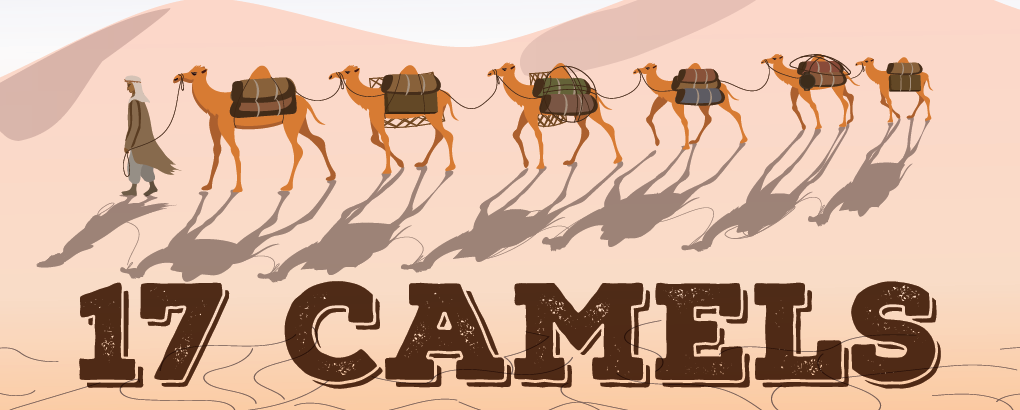A long time ago in a far away land there was a father with three sons. When he fell ill, he knew it was time to divide up his possessions to be passed down to his sons, the most valuable being his 17 camels.
He decided to give half the camels to his oldest son, one third of the camels to his middle son, and one ninth of the camels to his youngest son.
Because 17 does not divide in half, or into thirds, or into ninths, the three sons argued vehemently about how to divide up the camels.
After days of cantankerous negotiations with no resolution, they agreed to consult the old wise man in their village to let him decide.
The old wise man said, “I cannot decide for you, but I can give you my camel, so you have 18.”
So, the oldest son took half (nine camels), the middle son took one third (six camels), and the youngest son took one ninth (two camels), just as their father had prescribed, and all three sons were happy.
But that totaled 17 camels, so there was one left over. They asked the old wise man what they should do with it. He replied, “I will take back my own camel as compensation for helping the three of you learn a very valuable lesson in negotiation… you must give to get.”
***
Negotiation skill can make a multi-thousand dollar difference in crafting better deals. Whether you’re buying or selling cars, homes, or anything expensive, knowing what to say (and how to say it) matters.
Below are a few strategies employed by skilled negotiators. These techniques can be extraordinarily powerful, particularly with those who don’t know the following negotiation strategies.
Strategy #1: Time
Less time equates to more pressure. When we believe we have to make an immediate decision (even if in reality, we don’t) the other side will have an advantage, often enabling them to do better. It’s called the 80/20 Principle or Pareto’s Law, named for Italian economist, Vilfredo Pareto, who determined that 80% of concessions are made in the last 20% of a negotiation, when time is running out.
Takeaway: Determine if the other side has time pressure, and if they don’t, try to make them believe they do. Then hold the line and keep re-presenting your original position. Finally, giving up just a smidgen at the end allows the other side to save face while you make a better deal.
Strategy #2: Options
Time is a common strategy applied in negotiation, but options are the most powerful. Imagine you are a seller and your prospective buyer wants a substantial price concession. If that buyer believes you have options, such as others about to buy, you can usually hold firmer on price.
Takeaway: Think carefully about your options, or try to create options, and make sure the other side knows you have them.
Strategy #3: Information
Just like options and time, the side with the most information has the advantage. When you know more about your opponent’s situation, you can leverage it to make a better deal.
Takeaway: Take the time to learn about the other side, their needs, their motivation, and their urgency. Then figure out how to leverage it to your advantage.
Strategy #4: Communication
Time, options, and information are the weapons of negotiation. Communication is how skillfully and effectively you leverage them. Convincing your opponent that you are in a better position puts you in the power seat in their eyes. Remember… it’s not whether you actually have power (it’s better if you do), but it’s whether you are perceived to have power.
Takeaway: Time, options, and information are your negotiation tools. Communicating them effectively is your negotiation advantage.
“The most dangerous negotiation is the one you don’t know you’re in.” Christopher Voss












